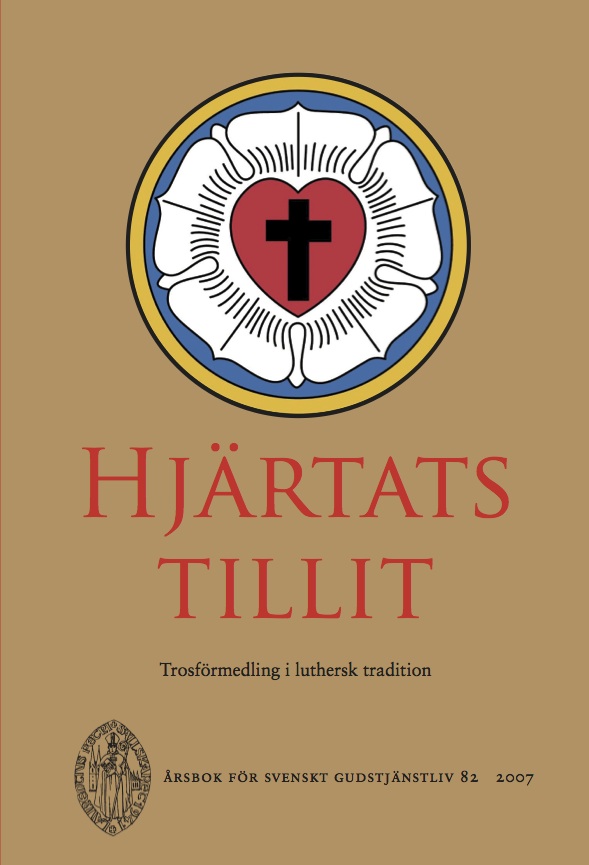Andlig frihet versus katekestvång. Vad är "lutherskt"?
Abstract
Spiritual Freedom vs. Obligatory Catechesis. What is "Lutheran"?
During about 350 years, Martin Luther’s Small Catechism held the position as obligatory basic textbook for religious instruction in Sweden, in school as well as church, initially even for learning to read. For Luther, the essence of the Christian gospel is the spiritual freedom attained through the death and resurrection of Jesus Christ, a liberation from the destructive forces in life: sin, death, evil. It is a gift out of pure divine grace received in your »heart» through a faith deeply rooted in emotional as well as intellectual life. In his explanation of the articles of faith, Luther invited the listener/reader to a purely personal assimilation of their content through formulations like »... has liberated me...». However, used as pedagogical instrument in a mostly authoritarian education, the catechism (whose fixed questions and answers had to be learnt by heart) unavoidably often became associated with constraint rather than freedom. Furthermore, an appended »house table» containing apostolic exhortations about the Christian way of living reminded you that the gospel did not free you from your position in the patriarchal order of family and society.
In Sweden, officially valid editions of the catechism from 1689, 1811 and 1878 contained a further dogmatic development of Luther’s explanations in an intellectualistic orthodox spirit (1811 partly revised in »neological» direction, 1878 restored but remarkably toned down). This »short»(!) development was much longer than Luther’s explanations, 1878 having 90 pages following Luther’s 15 pages. The »house table» had been considerably expanded, forming a third main part of the catechism rather than an appendix, and provided with rubrics reflecting the patriarchal social order. It also had been given an introduction enjoining laboriousness and condemning laziness. Ever since the reformation, the church in Sweden had been intimately linked to royal authority, and the »house table» became an important instrument for evoking obedience to the authorities in state, church, working life and household. We can imagine that whereas people in general surely have had difficulties in assimilating the dogmatic contents of the »further development», they have had no difficulties whatever to understand the exhortations in the »house table», which had obtained a main weight in the catechetical study never intended by Luther. (This is probably the reason why present-day Swedish press commentators repeatedly propagate an undeserved posthumous reputation of Luther as some kind of slave-driver.)
During the latter part of the 19th century, Luther’s catechism (still including the »further development» and the expanded »house table») became more and more criticized, mainly by political liberals and by dissenting Christians. 1919, it was totally abolished (even Luther’s original version) as textbook in Swedish public schools. The ministers of the Swedish Church, too, wanted more freedom in choosing materials for the instruction of confirmation candidates. In the new Swedish hymn-book from 1937, the original of Luther’s Small Catechism was given a new translation containing his explanations of the Christian faith, but its appended »house table» had been excluded. Within the course of the 20th century, a lot of new pedagogical materials appeared. The demand for a pedagogy more adapted to the conditions and questions of the pupils won more and more support also by central church authorities. Today, Luther’s Small Catechism is hardly used at all in confirmation groups.
Around the commencement of the new millennium, the bonds between church and state in Sweden were dissolved, the Swedish church being regarded as a religious community among others in the country. To separate it from others, it is (for the first time!) officially defined as »an Evangelical Lutheran community» – in a time when its specific »lutheran» character probably is less obvious than ever. The present author wanted to find out if »lutheran» traits are discernible in pedagogic materials used in today’s Swedish church. In 1993–94, the central directorate of the church emitted »The Small Book on Christian Faith» soon followed by a »Large Book» called »The Liberation»; the two were obviously meant as modern counterparts to Luther’s Small and Large Catechisms. The works discussed in the present essay are »The Small Book», and one of many existing textbooks for confirmation groups, »Con Dios» (2004), the latter especially complimented on its first-class pictorial materials.
An obvious »Lutheran» trait is in both cases the focus on freedom, liberation, and Jesus Christ as liberator. There are, however, also obvious differences in the choice of New Testament texts to support the main message. Whereas Luther sees the liberation as rather exclusively effected through Christ’s sacrificial death, the modern renderings regard Jesus’ whole life on earth, his words and deeds, as liberating, the death on the cross forming the crown on this. For Luther, the Pauline statements on justification stood forth as »the doctrine with which the church stands or falls». »The Small Book», with good exegetical reasons, states that the Pauline way to interpret Christ’s lifework should rather be seen as one interpretation beside several others, e.g. the Johannine way. The present author agrees, and suggests that the more basic doctrine of the incarnation should rather be seen as »the doctrine with which the church stands or falls»: that God has assumed human shape in Jesus, that death therefore could not retain him; he is risen from death, living and present in his church and in the hearts of his believers through the Holy Spirit. This doctrine is clearly confessed in both the books investigated. It is indeed a doctrine basic for Lutheranism – as for the whole of Christendom.
Downloads
Published
Issue
Section
License
© the authors, Laurentius Petri Sällskapet för Svenskt Gudstjänstliv and Artos & Norma Bokförlag. Copying and using material from Svenskt Gudstjänstliv for scholarly purposes is permitted as long as the source is indicated. For other uses, please contact the respective author as well as the publisher. Special restrictions may apply to images.


